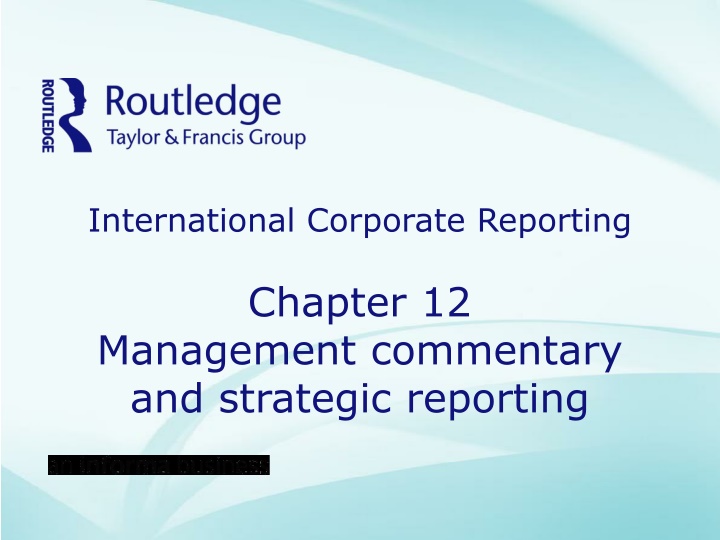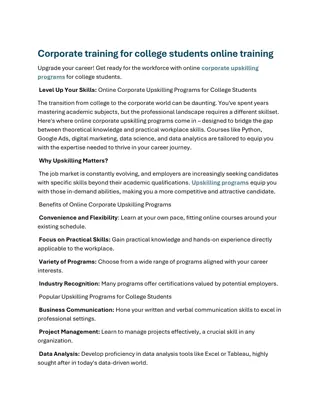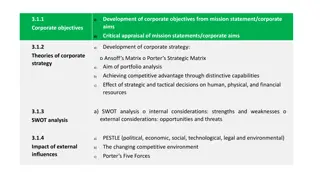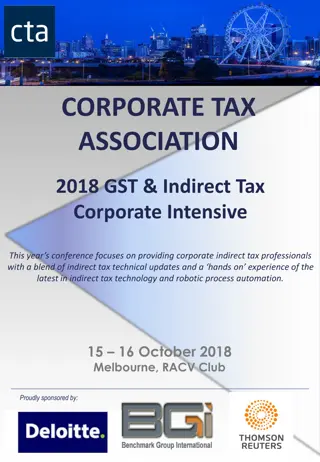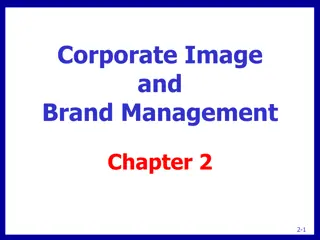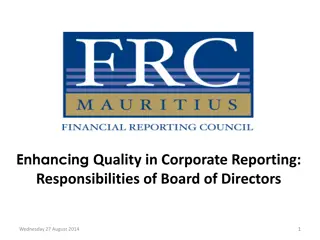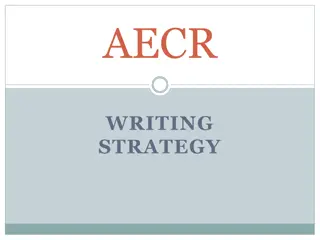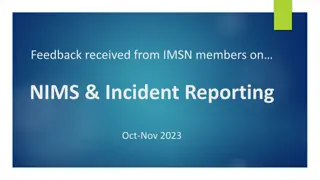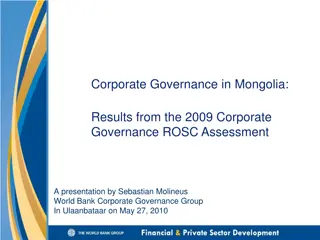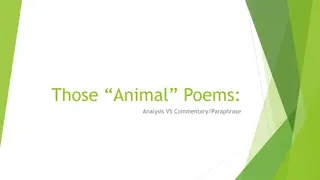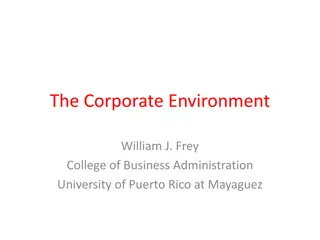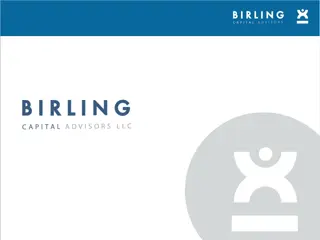International Corporate Reporting - Management Commentary and Strategic Reporting
In the realm of corporate reporting, management commentary plays a crucial role in providing insights into strategic decision-making processes. This chapter delves into the nuances of presenting financial information and analysis through the lens of management, focusing on key elements such as liquidity, capital resources, results of operations, and market risk disclosures. The discussion also encompasses the requirements laid out by the SEC for annual reports and Form 10-K filings, emphasizing the importance of meaningful disclosures and transparent reporting practices.
Download Presentation

Please find below an Image/Link to download the presentation.
The content on the website is provided AS IS for your information and personal use only. It may not be sold, licensed, or shared on other websites without obtaining consent from the author.If you encounter any issues during the download, it is possible that the publisher has removed the file from their server.
You are allowed to download the files provided on this website for personal or commercial use, subject to the condition that they are used lawfully. All files are the property of their respective owners.
The content on the website is provided AS IS for your information and personal use only. It may not be sold, licensed, or shared on other websites without obtaining consent from the author.
E N D
Presentation Transcript
International Corporate Reporting Chapter 12 Management commentary and strategic reporting
US Management Discussion and Analysis
Management discussion and analysis (US) SEC requires annual report on Form 10-K. Public document Content of Form 10-K is in Regulation S-K. Form 10-K may be published as a separate document, or may be cross-referenced to an annual report. Should be principles-based and give meaningful disclosures.
MD&A in Regulation S-K Subpart 229.300 Financial Information 229.301 (Item 301) Selected financial data 229:302 (Item 302) Supplementary financial information 229.303 (Item 303) Management s discussion and analysis of financial condition and results of operations 229.304 (Item 304) Changes in and disagreements with accountants on accounting and financial disclosure 229.305 (Item 305) Quantitative and qualitative disclosures about market risk 229.306 (Item 306) [Reserved] 229.307 (Item 307) Disclosure controls and procedure 229.308 (Item 30) Internal control over financial reporting
Outline structure Discuss each of three years financial condition, changes in financial condition and results of operations. (1) Liquidity (2) Capital resources (3) Results of operations (4) Off-balance sheet arrangements (5) Tabular disclosure of contractual obligations
Discussion required for operations unusual or infrequent events or transactions or any significant economic changes. known trends or uncertainties. extent to which material increases in net sales or revenues are attributable to increases in prices or to increases in the volume or amount of goods or services being sold. impact of inflation and changing prices.
Market risk disclosure Quantitative information for each category of market risk exposure (i.e., interest rate risk, foreign currency exchange rate risk, commodity price risk, and other relevant market risks, such as equity price risk). Qualitative information about market risk (i) Primary market risk exposures (ii) How those exposures are managed (iii) Changes in either of the above
Forward-looking information Risk of legal action if making forecasts Private Securities Litigation Reform Act of 1995 allows the SEC to clarify a safe harbor of protection against legal action in respect of forward-looking statements. The forward-looking statements must be made outside the financial statements and notes. Must state factors that could affect the financial performance or cause actual results to differ from any estimates made in forward-looking statements. ( Cautionary statement )
Nature of cautionary statement Forward-looking statements include predictions of future results or activities and may contain the words expect, believe, will, will deliver, anticipate, project, should, or words or phrases of similar meaning. .. Our actual results or activities may differ materially from these predictions. Our future results could be affected by a variety of factors, including
Fair disclosure Regulation FD Regulation FD aims to promote full and fair disclosure. SEC had become increasingly concerned about the selective disclosure of material information by issuers. When an issuer discloses information to certain individuals or entities e.g., securities market professionals, such as stock analysts, or holders of the issuer's securities the issuer must make public disclosure of that information.
EU Management report and corporate governance report Management Report (Ch 5 Art 19) Required contents will include: Fair review of the development and performance of the business, with a description of the principal risks and uncertainties it faces. Balanced and comprehensive analysis of the development and performance of the business and its position. Financial and non-financial key performance indicators relevant to the business including environmental and employee matters. Likely future development. Activities in research and development. Use of financial instruments. Financial risk management objectives. Risk and cash flow risk.
EU Management report and corporate governance report (contd) Corporate Governance Report (Ch 5 Art 20) Required contents will include: Code the entity is required to apply. Code it has applied voluntarily. Any corporate practices applied beyond a code. Any departure from a code and reasons. Main features of internal control and risk management system. Operation of shareholders meeting and key powers.
Extractive industries Accounting Directive states that, in order to provide for enhanced transparency of payments made to governments, large undertakings and public-interest entities which are active in the extractive industry or logging of primary forests should disclose material payments made to governments in the countries in which they operate in a separate report, on an annual basis.
Non-financial reporting Concern of European Parliament that businesses divulge information on sustainability such as social and environmental factors, with a view to identifying sustainability risks and increasing investor and consumer trust 2014 Directive amended 2013, stated that disclosure of non- financial information is vital for managing change towards a sustainable global economy by combining long-term profitability with social justice and environmental protection.
Non-financial reporting (contd) Large undertakings which are public-interest entities, having an average number of 500 employees or more during the financial, year shall include in the management report a non-financial statement containing information to the extent necessary for an understanding of the undertaking's development, performance, position and impact of its activity, relating to, as a minimum, environmental, social and employee matters, respect for human rights, anti-corruption and bribery matters. (May be separate report).
IASB Management Commentary Non-mandatory Practice Statement in 2010, setting out principles to be applied where a management commentary is provided that relates to financial statements presented in accordance with IFRS Standards. (For review 2020). Help users see the business through the eyes of management. It should provide management's view of the entity's performance, position and progress (including forward looking information).
IASB Management Commentary (contd) The main headings indicated are: The nature of the business. Management's objectives and its strategies for meeting those objectives. The entity's most significant resources, risks and relationships. The results of operations and prospects. The critical performance measures and indicators that management uses to evaluate the entity's performance against stated objectives.
Remuneration reports Remuneration covers all the rewards made available to an employee. (e.g.wages and salary, cash bonus, shares in the business, benefits in kind such as the use of a car, an option to buy shares, and contributions to a pension scheme. In the US and other countries that apply US terminology, called compensation . US companies remuneration is reported in proxy statement . UK companies in annual report
Contents GSK plc (UK) Chairman s annual statement Annual report on remuneration fixed pay (salary benefits and pension contributions) and pay for performance (annual bonus and vesting of LTI awards) Detail for each executive director Comparator industry groups Annual bonus basis and calculations, Scorecards for each executive director Long term incentives, basis for award and calculation CEO pay comparison Governance of the remuneration process Non-executive directors fees, Directors interests in shares Summary and future direction of remuneration policy
Contents Tiscali Group (Italy) Short section in annual report. Cross reference to a separate Remuneration Report, one year behind current annual report. Describes remuneration policy, remuneration of each director, board of statutory auditors and key management personnel.
Dual listing and communication dual listing or cross listing means listed on more than one national stock exchange. Benefits could be: Signalling commitment to strong governance, higher visibility, a larger shareholder base, increased analyst following.
Dual listing on US exchange foreign private issuers must report annually to SEC on Form 20-F less onerous than Form 10-K but includes an MD&A report. Exempt from the US proxy rules. Not subject to the detailed compensation disclosure rules. Exempt from Regulation FD (see section 12.2.4).
Dual listing and reporting Content of a management commentary or similar discussion in the annual report of a dual listed company is likely to reflect the interactions of more than one jurisdiction, so that what appears voluntary under one jurisdiction is in fact being driven by what is mandatory under another. Even within one jurisdiction, a desire to reach out to investors in an international language (such as English) may affect the extent of reporting in the local language.
Transparency The significance of transparent, timely and reliable financial statements and its importance to investor protection has never been more apparent. The current financial situations in Asia and Russia are stark examples of this new reality. These markets are learning a painful lesson taught many times before: investors panic as a result of unexpected or unquantifiable bad news. (SEC chairman on 1997 Asian financial crisis)
Meanings of Transparency Full disclosure, Public debate, Easily seen through, recognised, understood, or detected, Covered in conceptual framework by faithful representation, neutrality, completeness and understandability, Important to corporate public accountability in times of crisis.
Research examples Forward-looking information. Automated scoring of narrative reports, relating investor reliance to quality of earnings. Risk disclosures. Content analysis of four banks reports. Business models in strategic reporting. Literature review of different national frameworks. Identifying transparency. Scanning financial press for all uses of the words transparent or transparency connected to financial reporting.
